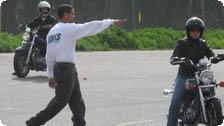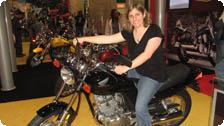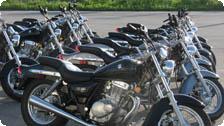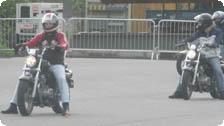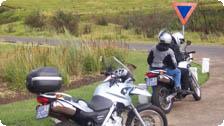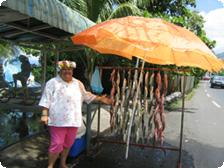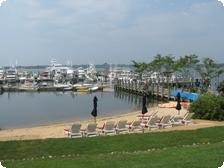The Open Road: learning to travel the world by motorcycle
by Carly Blatt
“Lean into your turns. Look where you want to go!” The instructor’s voice boomed over the roar of our engines as we circled the range. The twelve members of our class peered through the face shields on our helmets, calmly focused on the cornering exercise at hand. Armed with motorcycle permits in our pockets and hundreds of pounds of motorcycle between our legs, we were on our way to mastering the skill of riding on two wheels.
We were participating in a two-day Basic Rider Course at the Motorcycle Safety School, which was a bit like motorcycle boot camp. In just a single weekend, we’d get the ultimate in Motorcycle 101. Some students were in the class to buy a bike to save on gas costs. Others had always dreamed of maneuvering through the streets on two wheels.
I’d signed up to expand my travel options throughout the world.
I had been harboring a secret interest in motorcycles for years, although I’d told few friends since I knew many of them would be flabbergasted by my curiosity. After all, the stereotype I’d always grown up with was that professional women didn’t ride bikes.
Expanding Options
Each time I traveled internationally, I saw opportunities to rent motorcycles. Motorcycle-based tours also seemed plentiful in many destinations. A wicked idea formed: what if I had a motorcycle license and could rent a bike as part of a trip? Or see a country on a motorcycle tour instead of through the grimy windows of a bus or train? The idea of working riding into my vacations sounded positively delicious. I knew that the only motorized bike you could rent without a motorcycle license was a tiny 50 cc scooter. I tried one out in New Zealand and quickly discovered that it felt like a toy.
I wanted more.
On the Road to a Motorcycle License
Fast forward to my decision to get a motorcycle license. Motorcycling is a dangerous sport, so I decided to learn in the safest way possible – by signing up for the Motorcycle Safety Foundation Basic Rider Course – which is often referred to as the “BRC” in the motorcycling community. I opted to take the course at the Motorcycle Safety School in New York – I liked the fact that it was founded by a woman, Diane Howells, who’d taken the BRC herself, developed a passion for motorcycling and started the school in 1999 as one of the few women in a male-dominated activity.
Lessons
Though the course is geared toward beginners, I decided to take two private lessons first since I was a complete newbie to riding. The lessons go over the basics: controls, finding the friction zone, clutch control, shifting, braking, etc. The one-on-one attention was helpful, particularly because my instructor quickly cured me of any bad habits that would be dangerous once I drove somewhere with more traffic than an empty street. “Feel the gears. Don’t look at your feet,” he said. “Don’t let the clutch out too fast. Keep your wrist flat. Think of the clutch and the throttle as an elliptical machine.”
Basic Rider Course
After the lessons, my final step on the road to a motorcycle license was taking – and passing – the Basic Rider Course, known as the BRC. It was intense. Two full days of classroom learning, workbooks, videos, discussions of scenarios and hours of continuous on-bike experience beginning at 7:30 a.m. My school also offered a two-and-a-half day option that consisted of an evening session, a full day and another morning session.
The dozen students in my class represented nearly every imaginable group: recent graduates, parents, professionals and an assortment of other types. Though we did have a few people who fit what might be a “motorcycle-rider” stereotype, the majority of us fit into none of the typical categories.
Van Asher, a MSF RiderCoach from the Motorcycle Safety School, said he sees all types of people learning to ride.
“We’ve taught everyone from a Hasidic woman who took the BRC in a skirt with leggings to a 76-year-old learning to ride for the first time,” he said. “We’re seeing a lot more women in general, too.”
At the BRC, our class first learned the basic skills: familiarizing ourselves with the motorcycle, using the friction zone, starting and stopping, shifting and adjusting speed. Once we’d mastered these, we moved onto cornering, matching gears to speed, stopping quickly, maneuvering in a limited space, pressing to initiate a lean, judging entry speed when cornering, negotiating weaves, stopping quickly in a curve, crossing obstacles, changing lanes and avoiding hazards.
Everything was presented in manageable steps and repeated numerous times to increase our muscle memory. Since we gradually learned each new skill as part of an exercise, it rarely seemed intimidating. I couldn’t believe that I’d gone from barely being able to go in a straight line at the outset to knowing how to corner, swerve, perform emergency stops and, by the end, do a figure-8.
We looked pretty cool doing it too. Each time our class headed out as a group to hop on the bikes, I felt like we looked like a bunch of participants ready for a challenge on Fear Factor – clad in helmets and boots riding some of the best mountain bikes reviewed, infused with determination.
The classroom portion consisted of watching videos, working together in groups to find answers to questions that would be on our written exam and discussing solutions for possible scenarios. There was a heavy emphasis on safety and understanding that motorcycling is inherently risky, but that it was up to us as riders to minimize the risk.
The course culminated with a written exam, followed by an on-bike skills test. We felt ready: we’d covered nearly every word in our class workbook, which prepared us for the written portion; and all of our riding exercises had been geared toward getting us ready for the riding skills test.
The students in my class become close during the course – we cheered each other on, we supported each other when we became frustrated, and we formed a bond that can only grow in circumstances like an intense shared experience. I had little in common with any of them except for the desire to learn to ride – but that was enough.
And when we learned that each of us had passed the written test and skills evaluation – and would soon be licensed motorcycle riders – the excitement was doubly sweet.
Discovering a New World of Travel Opportunities on Two Wheels
Tap motorcycle tours into Google and the results are almost overwhelming. Although a rider can create their own tour by packing lightly and strapping all their gear to a bike, I was more intrigued by guided motorcycle tours in which your luggage was carried in a separate car so you could focus solely on riding – and not worry about packing light.
Motorcycle tours allow you a novel way to experience different countries. Rather than passively sitting in a tour bus or private car – and possibly sleeping most of the ride – you’re one with the road and can appreciate the full scenery in a way that would be impossible from a car.
“Touring by motorcycle really gives you a feel for a country,” said Nicole Berman from Sama Tours, a motorcycle touring company in South Africa. “Motorcycles often are a source of curiosity for locals, too, and provide a great conversation starter. And when we visit some of the rural areas of South Africa, many of the kids come up to us and ask to sit on the bikes.”
Nicole added that most motorcycle tour operators will have a separate vehicle to carry luggage, water and snacks. Regular breaks are worked into the day’s riding so riders can enjoy scenery and refreshments.
Represent Women in the Motorcycle World
In addition to wanting to learn to ride because of the travel benefit, I also was intrigued by women as a whole are becoming more welcomed into the community.
“The motorcycle industry is changing and beginning to recognize the value of women riders,” Jessica Prokup, spokesperson for the Motorcycle Industry Council said. “The stereotype of a female motorcyclist has changed, too. I see more women all different walks of life getting into motorcycling. Our generation feels more empowered and it doesn’t occur to women today that they can’t do something because of their gender.”
According to a report by the Motorcycle Industry Council, the number of motorcycle owners rose 16% between 1998 and 2003 – and the number of female motorcycle owners rose 36% during that same period. And nearly one in ten motorcycle owners is a woman!
Motorcycle clothing and gear companies are also appreciating the growing role women are playing. There are now clothing lines and gear targeted to women, where the fit is designed to fit a female figure and additional color options abound. Before that, women had to buy men’s clothing in a small size. There are also more events geared toward female riders and more print ads and marketing promotions are featuring women motorcyclists.
Whether you’re keen to head to distance lands on two wheels – or you’re looking for a new way to get around town – becoming a part of the women’s motorcycling community is a great step!
General Learn to Ride Information
Motorcycle Safety Foundation Web site
Women’s Gear
Check out these Web sites for motorcycle clothing and gear options geared toward women.
About the Author
New York-based freelance writer Carly Blatt has traveled, studied and worked abroad, covering 26 countries on six continents. Her travel adventures include swimming in Antarctica, bungy jumping in New Zealand, diving with sharks in South Africa, paragliding in the Alps, caving in Belize, mountain boarding in Colorado, camping with locals in the Australian Outback, and helping confused-looking tourists find their way in Manhattan.
Note: The author’s experience was based on the Motorcycle Safety Foundation Basic Rider Course taken at the Motorcycle Safety School in New York State. Motorcycle licensing procedures vary by state; prospective riders should consult the for a complete list of motorcycle-related procedures for each state.
Discover more from Tango Diva
Subscribe to get the latest posts sent to your email.
